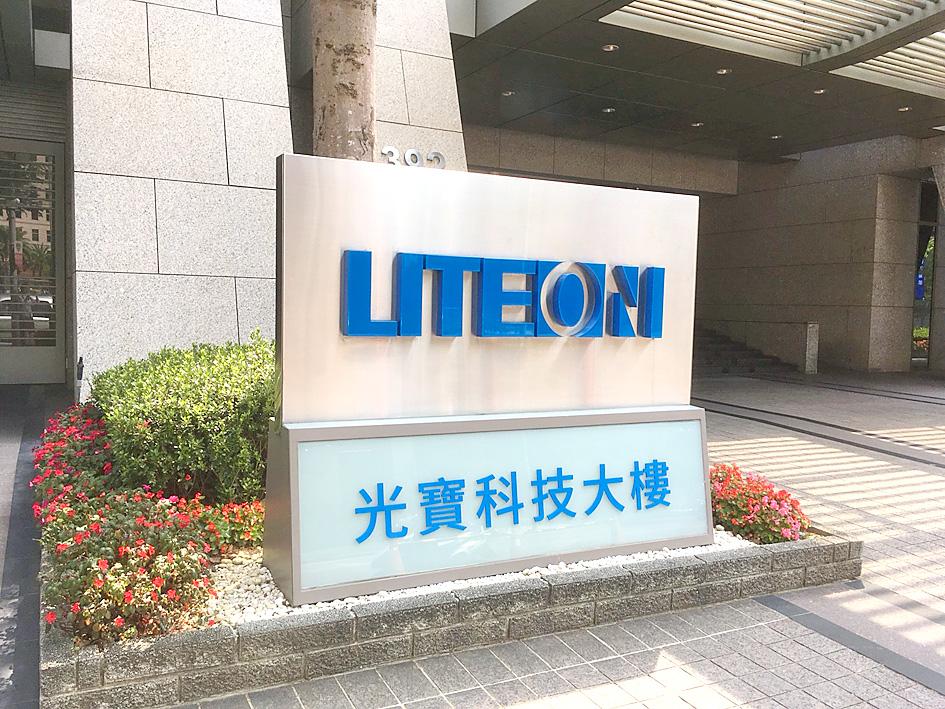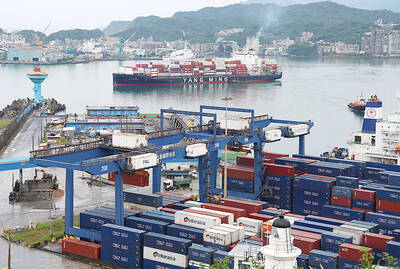Electronic components supplier Lite-On Technology Corp (光寶科技) yesterday said it expects revenue to grow at a quarterly pace of 10 percent this quarter, thanks to shipment delays of some automotive devices, computers and consumer electronics due to key component shortages.
The company’s revenue last quarter grew to NT$41.86 billion (US$1.49 billion) — its highest level in about seven quarters.
“The fourth quarter is normally an off-season ... but the third quarter [revenue] was affected by component and material shortages. We believe it should be okay to [expect] 10 percent revenue growth in the fourth quarter,” Lite-On president Anson Chiu (邱森彬) told investors in an online conference yesterday.

Photo: Chen Rou-chen, Taipei Times
The company was concerned about the chip shortage, but it altered its product designs at the beginning of this year to minimize the impact, Chiu said, adding that China’s electricity curbs have had a very limited effect on Lite-On as it has expanded capacity in Taiwan, Thailand and Vietnam.
Automotive electronics and cloud-based and artificial intelligence of things (AIoT) devices, both of which deliver a higher gross margin than the corporate average, would be the main growth drivers this quarter, extending last quarter’s robust growth momentum, he said.
The company also maintains an optimistic outlook for next year as its optoelectronics business is expected to grow 15 to 20 percent year-on-year, Chiu said.
Lite-On’s optoelectronics business, which offers outdoor lighting, automotive electronics and optoelectronic product solutions, contributed 20 percent to its revenue last quarter.
Its cloud and AIoT business made up 28 percent of the company’s revenue, with products including electronic components used in data centers, servers and smart devices.
Electronic components for information technology and consumer electronics products such as notebook computers and game consoles were the biggest source of revenue, making up about 52 percent, the company said.
Lite-On yesterday reported that net profit grew 3 percent to NT$3.08 billion last quarter from NT$2.99 billion a year earlier, thanks to robust demand for power units used in cloud computing devices, electric vehicles and PCs.
That represented a quarterly decline of 24 percent from NT$4.03 billion, after some impairment losses were booked.
Earnings per share rose to NT$1.33 last quarter from NT$1.29 a year earlier, but dropped from NT$1.74 in the second quarter.
Gross margin rose to 19.3 percent last quarter from 19 percent a year earlier, but declined from 19.7 percent in the second quarter.

CHIP RACE: Three years of overbroad export controls drove foreign competitors to pursue their own AI chips, and ‘cost US taxpayers billions of dollars,’ Nvidia said China has figured out the US strategy for allowing it to buy Nvidia Corp’s H200s and is rejecting the artificial intelligence (AI) chip in favor of domestically developed semiconductors, White House AI adviser David Sacks said, citing news reports. US President Donald Trump on Monday said that he would allow shipments of Nvidia’s H200 chips to China, part of an administration effort backed by Sacks to challenge Chinese tech champions such as Huawei Technologies Co (華為) by bringing US competition to their home market. On Friday, Sacks signaled that he was uncertain about whether that approach would work. “They’re rejecting our chips,” Sacks

Taiwan’s exports soared 56 percent year-on-year to an all-time high of US$64.05 billion last month, propelled by surging global demand for artificial intelligence (AI), high-performance computing and cloud service infrastructure, the Ministry of Finance said yesterday. Department of Statistics Director-General Beatrice Tsai (蔡美娜) called the figure an unexpected upside surprise, citing a wave of technology orders from overseas customers alongside the usual year-end shopping season for technology products. Growth is likely to remain strong this month, she said, projecting a 40 percent to 45 percent expansion on an annual basis. The outperformance could prompt the Directorate-General of Budget, Accounting and

NATIONAL SECURITY: Intel’s testing of ACM tools despite US government control ‘highlights egregious gaps in US technology protection policies,’ a former official said Chipmaker Intel Corp has tested chipmaking tools this year from a toolmaker with deep roots in China and two overseas units that were targeted by US sanctions, according to two sources with direct knowledge of the matter. Intel, which fended off calls for its CEO’s resignation from US President Donald Trump in August over his alleged ties to China, got the tools from ACM Research Inc, a Fremont, California-based producer of chipmaking equipment. Two of ACM’s units, based in Shanghai and South Korea, were among a number of firms barred last year from receiving US technology over claims they have

BARRIERS: Gudeng’s chairman said it was unlikely that the US could replicate Taiwan’s science parks in Arizona, given its strict immigration policies and cultural differences Gudeng Precision Industrial Co (家登), which supplies wafer pods to the world’s major semiconductor firms, yesterday said it is in no rush to set up production in the US due to high costs. The company supplies its customers through a warehouse in Arizona jointly operated by TSS Holdings Ltd (德鑫控股), a joint holding of Gudeng and 17 Taiwanese firms in the semiconductor supply chain, including specialty plastic compounds producer Nytex Composites Co (耐特) and automated material handling system supplier Symtek Automation Asia Co (迅得). While the company has long been exploring the feasibility of setting up production in the US to address